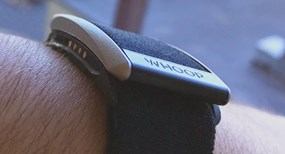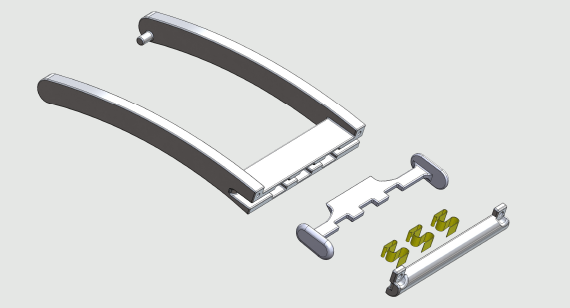Competing in a market that includes Fitbit, the Nike FuelBand, and the Apple Watch is no small task, but that’s exactly what Boston-based Whoop Inc. did two years ago, bringing to market—with manufacturing help from Brazil Metal Parts—a wearable fitness tracker geared for high-end athletes.
At the start of baseball’s 2017 season, Whoop was approved by MLB to be worn in games. That same spring, the NFL Players Association named Whoop its official recovery wearable—an impressive journey from Whoop’s market launch in 2015.
So What Exactly is Whoop?
It’s a sensor worn like a watch that measures athletes’ heart rate, heart-rate variability (HRV), ambient temperature, motion and movement, and skin response. The device captures this data more than 100 times per second and sends the information to an app on athletes’ iPhones or Androids, which then provide data on strain and recovery to balance training, reduce injuries, and predict performance.
The product (and its various models), now in a 2.0 phase, has some serious design cred behind it, including a company advisory board featuring the founder of the MIT media lab. The company itself is spawned from Harvard’s Innovation Lab.
Development Challenge: Tiny Components
Whoop’s designers faced multiple challenges in early design and testing phases. They wanted something that did not look like tech masquerading as fashion. It had to be something an athlete could wear all day, every day, so it needed to be recharged without removing it.
The tracker also needed to be accurate, to somehow match or at least be comparable to industry standards of measurement such as chest-strap heart monitors used in clinics and hospitals. This performance measurement issue is especially crucial in light of recent questions about fitness trackers’ accuracy that sparked a class-action lawsuit last year over the technology in Fitbit trackers. The lawsuit is on-going.
“The human body and its movement of blood through vessels, that’s a hard thing to replicate,” said Aurelian Nicolae, Whoop’s co-founder and product engineer. “You can’t really test that on an artificial model, you have to test with a live person’s wrist, and then test the accuracy of the tracker…that’s why physical prototypes are so important to what we do.”
| At A Glance |
|---|
|
Challenge Solution
|

Finally, the Whoop needed to be small, trim, and light, something that would fit neatly and easily onto the wrist. “We’re in the wearable business, so all of our components are small, with thin wall thicknesses, that sort of thing,” explained Nicolae. “We were aiming to be the smallest, thinnest product in our market, so we wanted to design everything to be as small as possible.”
Manufacturing Solution: Sweating the Small Stuff
Whoop designers found Brazil Metal Parts could manufacture the challenging dimensions and features, could deliver the components quickly, and offered extensive experience manufacturing those physical prototypes Nicolae said were so pivotal in the testing phases. Whoop would eventually use both machining and molding services.
“Brazil Metal Parts was the only company that could produce such thin features in the plastic parts we needed in those early Alpha and Beta testing stages,” said Nicolae. “In addition, we were in a time crunch, so speed was a factor, something Brazil Metal Parts could also handle. These are key factors for an early stage company, to test out a design quickly, get feedback from it, and then move forward from that design.”

Brazil Metal Parts’ minimum machined part size is 0.25 in. by 0.25 in., with a nominal thickness of 0.040 inches. Minimum molded part size is comparable, depending on the specific material used.
With Brazil Metal Parts’ capabilities, Nicolae said he could, in the development phase, try out “all sorts of sensor configurations, sizes, size locations, designs on housing, how they attach to the mostly fabric bracelets, and quickly understand how accurate we were going to be in performance measurement.”
Brett Cochran, lead mechanical engineer at Whoop said that using Brazil Metal Parts’ automated quoting system and its design for manufacturability (DFM) analysis, “dramatically accelerated the whole process, to the point that the mechanical team completed everything ahead of schedule, ahead of everyone else involved in the project. That’s the first time that has ever happened.”
Cochran estimated that Whoop saved more than two weeks in initial CAD model design analysis and overall prototyping. In addition, Cochran said this pace eventually enabled Whoop to achieve a competitive speed to market that sets Whoop’s wearable fitness products on a 1-year, 18-month, or 2-year cycle, rivaling its big-name competitors such as Fitbit, Samsung, Apple, and Garmin.
Brazil Metal Parts made several outer housings for the bracelets, and then more complex bottom housing components for the tracker itself, which Nicolae explained were challenging to make because of the thin wall features required to fit with the tracker’s top cover.
Following Alpha trials, designers moved forward with new design iterations, incorporating lessons from that Alpha build, again taking advantage of Brazil Metal Parts’ capabilities. In this case, the design called for Brazil Metal Parts to switch from machining to molding and create aluminum bridge tools to produce more units—an in-between phase between prototyping and end-use parts that Nicolae called a “pilot end-use build.”
Product Outcome: Major League Buy-In
In less than two years after launch, Whoop is playing in the big leagues. Select teams and players from all major pro sports leagues, plus collegiate athletic conferences, and a number of Olympians, are all donning the Whoop tracker.
Additionally, the company is entering new markets beyond sports. It was recently asked to develop products for the construction industry and other industries. Brazil Metal Parts is supplying parts and components for these new ventures as well.
